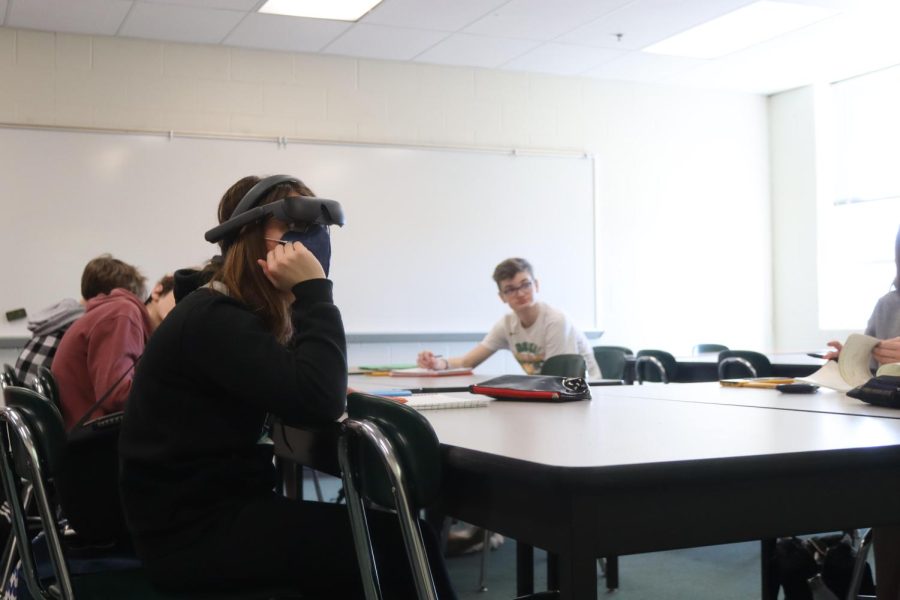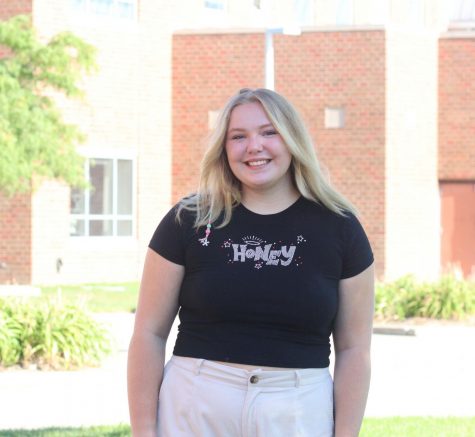Learning through a different lens
How technology helps a senior with visual impairment in the classroom
Senior Camile O’Neill sits in her honors pre-calculus class, where due to her visual impairment she uses eSight glasses that help her to see the board, teacher and her notes. O’Neil uses tech in all of her classes that help her in a variety of ways. “With my eSight glasses, I am able to take pictures of the board so I can study them later,” O’Neil said. “My laptop helps me get my work completed in an efficient way. Most of my teachers send me digital copies of all of my assignments, so they are all accessible to me.”
March 16, 2022
In day-to-day life technology can be used to help with just about anything. Low vision technology for people with visual impairments has advanced tremendously over the years to the advantage of many people. For senior Camille O’Neil, the low vision technology she uses in the classroom has helped her become a visual learner despite her visual impairment.
O’Neill was diagnosed with Retinopathy of Prematurity as an infant. This eye disorder caused both of her retinas to detach. Her doctors were able to repair the retina in her left eye but not her right. Due to this and glaucoma, a group of eye conditions that damage the optic nerve, O’Neill’s right eye was removed when she was 3-years-old.
“I now have a prosthetic eye,” O’Neill said. “Right now, the vision in my left eye is like a sighted person looking through a paper towel tube, putting wax paper on it and dotting it with a Sharpie.”
When O’Neill began elementary school, her primary method of reading and writing was Braille. As she got older, O’Neill decided to become a visual learner. O’Neill worked with teacher of the visually impared, Cynthia McNair, to help find the best ways for her to learn. From third through seventh grade she used an Onyx flip camera that helped her to see both near and far in the classroom, but the flip camera was large and bulky and had to be wheeled from class to class. In eighth grade, O’Neill got her eSight glasses These smart glasses completely changed the way she functioned in the classroom.
“During middle school, her family purchased her first pair of eSights,” McNair said. “At that time, the technology was relatively new and cutting edge in the world of low vision devices. Since that time, the eSights have made improvements, and the technology is more powerful and more portable than ever before.”
The glasses provide the magnification that O’Neill needs to be able to see anything at a distance in her classes, like the teacher and the board, in a more portable way than the flip camera she previously used. ESights work using an auto-focus camera that projects a high-resolution image onto a screen in front of O’Neill’s eyes. The glasses also make it possible for her to read regular sized print up close that would otherwise be difficult.
“With my eSight glasses, I can now have a device on my head where I can switch between seeing the screen and seeing worksheets I may need to complete,” O’Neill said. “Also with my eSight glasses, I can now take pictures of the board and save them as notes so I can review them later. I can also do regular print worksheets instead of having things blown up.”
O’Neill’s parents and teacher for the visually imapired have seen how her eSights have helped her to grow as a visual learner and enjoy activities outside of school.
“The eSights have been a game-changer for Camille,” father Bill O’Neill said. “Whereas classroom materials previously needed to be enlarged or photocopied for her, she can now participate as her peers do. Outside of the classroom, the eSights have allowed her to more fully enjoy watching sporting events, both live and on television.”
With the help of technology O’Neill was able to grow as a visual learner and will continue to do so as she finishes her high school education.








